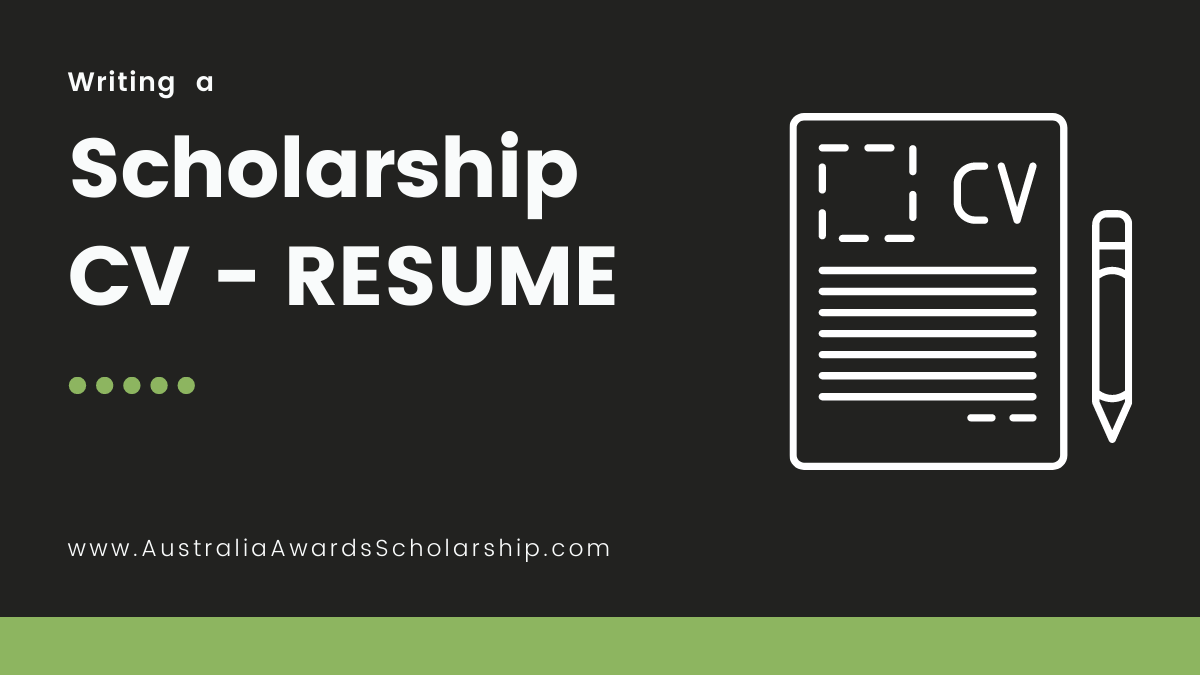Writing a CV for Australian Scholarship Application

Getting into a decent and nice enough college is hard. And, getting a scholarship to fund your way through your degree is even harder. You would only get a scholarship among all those applicants if you and your profile stand out in front of the scholarship committee.
There are a number of documents that are asked for if you want to apply for a scholarship, a scholarship CV, or a resume being one of them.
A scholarship resume and a scholarship CV are two different terms that very often are used interchangeably but are slightly different from each other. A resume is required for academic fellowships and research purposes and is usually confined to a single page. Whereas, a scholarship CV can be written on several pages articulating a student’s academic, professional, and personal achievements.
A scholarship CV also lists an applicant’s academic and career goals, his/her qualifications, research interests (if any), and/or any other notable awards, achievements, and publications. It basically contains everything that can help a pupil land a scholarship.
Writing a compelling scholarship CV requires good writing skills, organization, honesty, accuracy, and most of all, patience. But, don’t worry, you will get there. (Especially by following this holy grail guide of ours)
Steps to Composing the most Professional Scholarship CV:
- Gather the most Pertinent and Significant Information about Yourself:
Take your time. Start with collecting all the information that you think can make its way into your CV. It is good to get started with having all the information by your side instead of just diving right into writing a CV without planning out what you are going to put in beforehand.
After that, list down what is the most relevant information and what can be excluded. If you will put in every tiny achievement of yours, it will take forever to get through your CV, and, chances are, this little error of judgment can very well kick you out of the competition.
- Organize and Systematize:
It is very important to methodically organize all the things that are going to go into the CV. List your achievements in descending order putting the latest achievements first and then make your way through the timeline in a downward manner.
- Add Information such as:
A good scholarship CV would contain all kinds of the necessary information including but not limited to:
-
-
- The name of the applicant.
- The address.
- His/her contact details, such as email address, contact number, and emergency contact number.
- Nationality
- Date of birth
- Educational details, like grades, awards, publications, and honors
- Languages that the applicant can speak fluently or on an intermediate level.
- Pass time hobbies and extra-curricular activities.
- Job, internship, or voluntary experiences (if any).
- Technical skills etc.
-
It is also significant to mention how you think your career goals will be achieved by getting particular funding or scholarship. Don’t just go about mentioning that you are applying for a particular scholarship. Also, do not delve into articulating your religious or political views, your marital status, and your sexual orientation.
- Be Sincere and Truthful:
Honesty is the best policy. Lying on a scholarship CV or adding information that can’t be proved upon fact-checking can simply backfire on you. Don’t overrepresent your skills or achievements. Prevent from listing or exaggerating your irrelevant achievements. You should come off as professional and focused in front of the scholarship committee.
- Check for Grammar, typos, and Errors:
The last step of any kind of writing is always proof-reading. Before hitting the ‘send button or posting the CV, look for any grammar slips, spelling mistakes, or typos that you may have made. If the individual receiving or reading the scholarship CV catches these kinds of small mistakes, your application can possibly end up in the bin.
A well-written Scholarship Resume Strengthens your Profile:
Your personal statement will show a clear picture of your ambitions and your life in general. But, a scholarship CV brings color to it and gives it the kind of life that a personal statement can’t. Hence, you should deem a scholarship CV equally important.
It mentions all of your achievements, skills, and goals, and ambitions in an organized way. A suitable scholarship CV should follow a methodical way and should be easy to go through.
Start your Scholarship CV with:
-
- Your first and last name (goes without saying of course)
- Your home address including your postal code.
- Your contact number, which will include both your home and mobile number as well as the code of the area in which you live in.
- Your professional email address. Refrain from using email addresses that have nicknames in them or that do not sound professional.
- Your date of birth and your gender.
- Your nationality.
Wind up your Scholarship CV by listing down your:
-
- Academic achievements and relevant work experiences.
- Hobbies, interests, and relevant proficiencies.
- Two or three references. These references can be from your work or school and are meant to vouch for what you have listed in your scholarship CV.
How long should a CV be?
Your scholarship CV should be a maximum of two pages. Keep your tone professional and natural. Don’t use funky fonts and use bolds and italics only for heading and subheadings.
How to conclude a CV?
References are very useful and should be added if they are relevant to your CV. But you should never make up references as it can not only eliminate your chances of getting a scholarship, it can also jeopardize your admission into your dream school.
Keep the sentences short and simple. Focus on more recent achievements. Older ones need not be mentioned in great detail.
Lastly, be honest, precise, and concise.